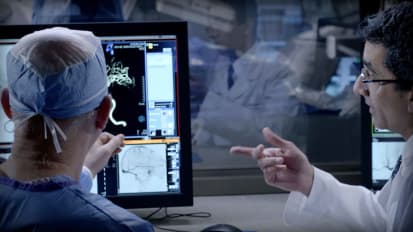
Recently Added
 Video
Video
The Impact of the Telestroke Program on Acute Ischemic Stroke
When a blood clot deprives the brain of oxygen, timely intervention is critical.
Neurointerventional Stroke Services
Neurointerventional stroke services at WVU Medicine use the latest evidenced-based medicine to deliver lifesaving care. As the first hospital in West Virginia to use neurointerventional techniques to treat stroke patients, we developed protocols for efficient, effective care that are now used by hospitals across the country.
Our multidisciplinary stroke team, including diagnostic and interventional neuroradiologists, stroke neurologists, and emergency medicine physicians, collaborates to offer fast, individualized care. The team is available 24 hours a day, 7 days a week to care for stroke patients.
During an ischemic stroke, a blood clot prevents blocks blood from flowing into the brain. Without oxygen from blood, millions of brain cells die every second minute. At WVU Medicine, our team goes into action immediately upon receiving notice from emergency medical services that a stroke patient is on his or her way to the hospital. The faster blood flow is restored to the brain, the greater chance for a good outcome.
Advanced Stroke Treatment Options
After arriving at the hospital, patients quickly undergo advanced neuroimaging, helping our expert physicians choose the treatment that is right for each individual. Imaging can reveal the size of the clot and its exact location in the brain.
Depending on the location size of the clot and how long ago the stroke began, patients may receive:
- t-PA, a medicine that dissolves blood clots
- Mechanical thrombectomy, a minimally invasive procedure to remove blood clots
Mechanical Thrombectomy
During mechanical thrombectomy, the inteventional neuroradiologist punctures an artery in the patient’s groin with a small needle. Using live, real-time X-rays as guidance, the physician threads a catheter through the artery in the groin and into the brain. The latest technology allows the interventional neuroradiologist to navigate tiny catheters and devices even in brain blood vessels that are only a few millimeters wide.
Once inside the brain, the physician uses a specialized device to remove the blood clot and restore blood flow to the brain.
Patients with blockages in large blood vessels (large vessel occlusions) often benefit the most from mechanical thrombectomy. Research also shows that patients with large-vessel blockages have better results and recoveries when they receive neurointerventional procedures immediately.
Mechanical thrombectomy can is also be used if patients cannot receive t-PA because their time of onset of symptoms began more than three hours before they arrived at the hospital or is unknown, for example if a patient wakes up with a stroke.